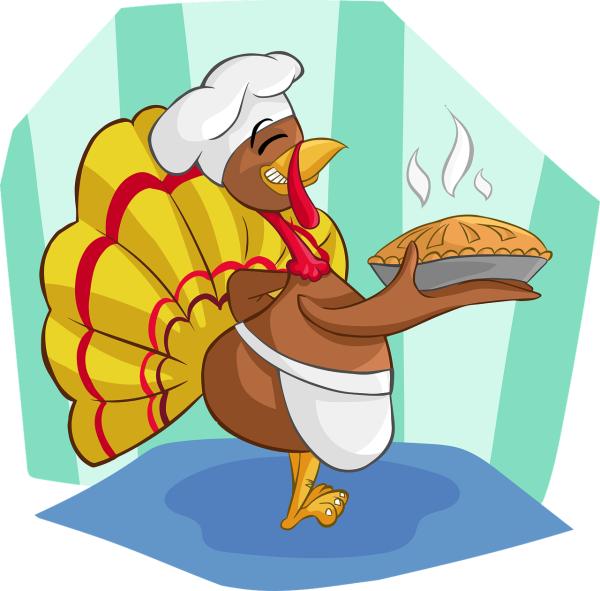How close is what we eat today to the original 1621 Thanksgiving feast? Apparently, not very close at all. Food historians agree that turkey was not eaten at the original feast; it is suspected that the menu probably included wildfowl, corn, porridge, and venison.
Why Do We Eat Turkey?
No one is sure.
One theory says that Queen Elizabeth, receiving the news that a fleet of Spanish ships had sunk on their way to attack England, was so pleased that she ordered another goose to be served with dinner. The early settlers were so inspired by this story that they decided to roast a bird easily found in North America, the turkey, instead of a goose. If your family’s tradition is to eat goose at Thanksgiving or Christmas, it may have come from Queen Elizabeth.
Historians agree that by the beginning of the 19th century, turkeys had become a very popular dish in the U.S. The reasons are simple: there were plenty of turkeys around, readily available for slaughter, and a single turkey was usually large enough to feed a family.
However, turkeys did not become associated with Thanksgiving until the middle of the 19th century. Some say it was due to Charles Dickens, A Christmas Carol. Others say it was Sarah Josepha Hale who wrote a novel in 1827 describing a New England Thanksgiving with turkey. Ms. Hale was the chief campaigner to make Thanksgiving a national holiday, believing it would help pull the country together as it edged closer to Civil War. In 1863, President Lincoln proclaimed Thanksgiving to be a national holiday.
Turkey contains protein and vitamins, including vitamins B-6 and B-12, niacin, choline, selenium, and zinc. The healthiest part of the turkey is the breast meat; the leg and thigh meat contain more fat and calories; that oh-so-crisp skin is the least healthy part. Turkey also contains the amino acid tryptophan, which causes sleepiness and often is cited as being the cause of family members falling asleep around the Thanksgiving table. However, all meats contain tryptophan, and turkey should not tire you more than beef steak for dinner.
What About Venison?
It turns out that the country may have been better served if we ate venison on Thanksgiving, like the early settlers, instead of turkey. Although turkey is quite healthy, venison is even more nutritious!
Like turkey, venison is very nutritious, with lots of proteins and vitamins. The difference is that venison is leaner meat and contains less fat and fewer calories than turkey or particularly red meat. Luckily, for deer, they have not been domesticated like turkeys, so they are far less likely to be found in the supermarket ready to roast.
The Side Dishes
Sweet potatoes are exceedingly healthy, except if you use my family recipe, which consists of baking them with loads of mini marshmallows melted on top. Sweet potatoes contain fiber, vitamins, and minerals.
Cranberries are another staple at many homes on Thanksgiving. Those of you from New Jersey should feel pride in knowing that the New Jersey Pinelands is one of the few places where cranberries grow naturally due to the ideal conditions of the bogs consisting of sandy, acidic soil. The first cranberry sauce was made in New Jersey in 1917. The maker of the sauce joined with another company to form Ocean Spray, a grower’s cooperative of 700 farmers in the US, Canada, and Chile.
Cranberries are very healthy. However, cranberries are very tart; cranberry juice and dried cranberries contain a great deal of added sugar to offset the tart taste. Many recipes call for several cups of sugar, which more than offsets the health benefits of cranberries!
The Pumpkin Pie Dessert
Pumpkins are a variety of squash; like sweet potatoes, they contain vitamins, minerals, fiber, and beta-carotene. They are native to the Western Hemisphere and were cultivated as a crop before today's corn, beans, or other staples.
Indigenous Americans have a very long history of farming pumpkins; it was a staple in their diet and often used for rituals and celebrations. Although those Native Americans may have brought them to the Pilgrims, historians agree that pumpkin pie was not served at the original 1621 feast. The Pilgrims would not have had butter, flour, or even an oven for baking.
Like sweet potatoes and cranberries, pumpkins are healthy in their natural state but become less so when combined with butter and sugar to appeal to our sweet tooth. In the late 1600s, a French chef recorded the first known recipe for pumpkin pie:
“Tourte of Pumpkin – Boil it with good milk, pass it through a straining pan very thick, and mix it with sugar, butter, a little salt and if you will, a few stamped almonds; let all be very thin. Put it in your sheet of paste; bake it. After it is baked, besprinkle it with sugar and serve.”
Today’s recipes remain faithful to the original, containing pumpkin, milk, eggs, sugar, cinnamon, nutmeg, butter, and a pastry crust.
Conclusions
Have a wonderful Thanksgiving, take a day off from worrying about what you eat, and if anyone tries the “Tourte of Pumpkin” recipe, let us know how it went.
Editor’s Note: For those wishing to take a deeper dive into Thanksgiving dinner, here are two classics from the ACSH archives.
From The Archives: The Great Cranberry Scare Of 1959




